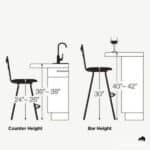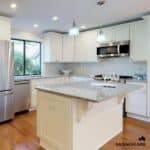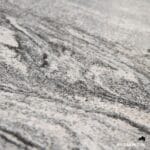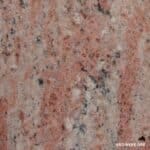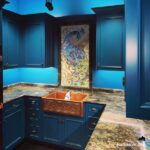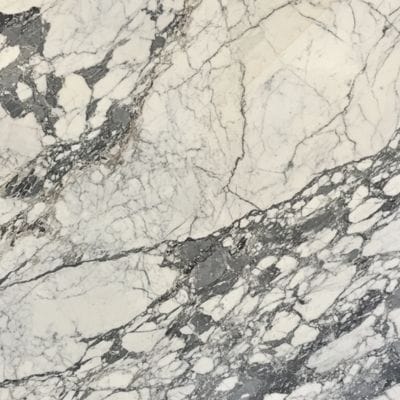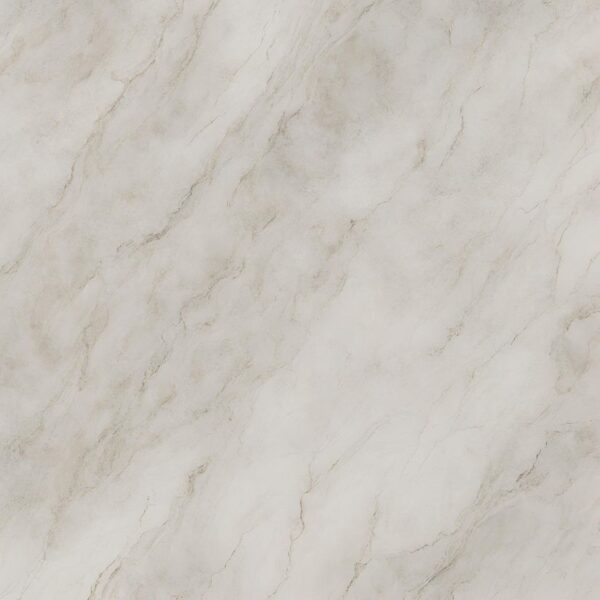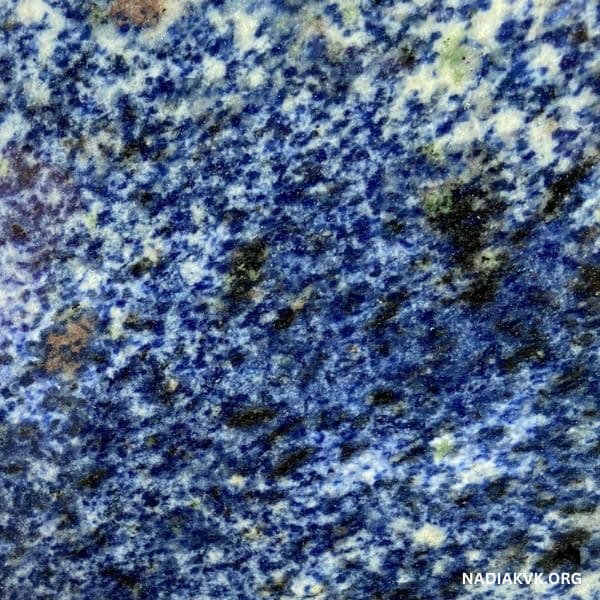Chalk paint vs cabinet paint are two common options that frequently come into play when it comes to giving your furniture a new look. Because each has a unique collection of traits, benefits, and drawbacks.
Painting furniture can transform its look and give used pieces new life. The distinctions between chalk paint and cabinet paint must be understood before you pick up the paintbrush. Because of both have their distinctive qualities, and your decision could have a big effect on how your project turns out.
Also in order to assist you in making an informed choice for your upcoming furniture restoration project, we’ll compare cabinet paint versus chalk paint in this post.
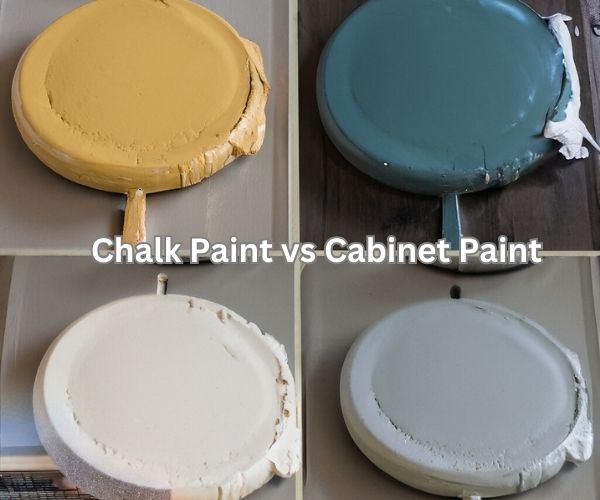
What is Chalk Paint?
A kind of hidden treasure in the worlds of interior design and furniture restoration is chalk paint. Because this paint has a different formula than typical paints.
There are many different colors of pigment mixed in with some chalk and calcium carbonate. When you apply it, it does its magic and leaves behind a distinctive matte finish that has a somewhat chalky sensation. It attracts attention since it adheres to almost everything, including cloth, glass, metal, and wood.
What’s even better? Priming and sanding are often not necessary. You can produce a variety of designs using chalk paint, from a comfortable shabby-chic atmosphere to a clean and futuristic finish.
Chalk paint is thus your go-to for giving furniture and home décor items a bit of individuality whether you like DIY projects or are a pro wanting to work wonders.
Read More: Can You Use Pine Sol on Granite Counters
Pros of using Chalk Paint

Learning about chalk paint can assist you to appreciate why it has such a dedicated following Because these are the most notable benefits:
No Priming Required: Forget spending hours prepping your furniture; the secret ingredient in chalk paint adheres to surfaces like glue. Your DIY project will go more smoothly because it saves you time and effort.
Versatile Finish: Chalk paint does not confine your imagination. From that wonderfully faded, vintage appearance to a sleek, contemporary finish, you may easily obtain a wide range of appearances. It is like to having several paint selections in one can.
Easy to Distress: Have you ever wanted your furniture to have a worn-in, weathered appearance? It becomes simple using chalk paint. You may distress your artwork to perfection with only some sandpaper or a damp cloth.
Read More: What Is The Cost Of Granite Per Square Foot?
Cons of using Chalk Paint
Considering the fact that chalk paint has a lot of benefits, it’s vital to be aware of its drawbacks as well:
Limited Durability: Chalk paint, while charming and aesthetically pleasing, is not the most durable choice for high-traffic areas. Because it excels in decorative uses, making it ideal for ornamental furniture or items that won’t see frequent use. However, on busy surfaces, chalk paint can wear down more quickly, leading to possible deterioration over time. For pieces that require greater durability, different paints may be a better choice.
Requires Sealing: To safeguard your chalk-painted masterpiece and maintain its stunning appearance, use a sealing wax or polyurethane coating. Also this extra step is necessary, but it increases the amount of time and work needed for your project overall. It’s similar to giving your creation a shield of protection so it can withstand the test of time.
Read More: Parquet Flooring
What is Cabinet Paint?
Cabinet paint is a specialist paint made for surfaces with high traffic, primarily cabinets, kitchen, and bathroom vanities. Thanks to a special formulation that combines hardeners and resins because it stands out for its longevity.
A strong finish that can withstand moisture, heat, and normal wear and tear is produced by this mixture. Cabinet paint can give your room a sleek, glossy, or satin finish to give it a contemporary, sophisticated feel.
However, in order to guarantee proper adhesion and durable effects, it often requires considerable surface preparation, such as sanding and priming.
Pros of using Cabinet Paint
There are various benefits to painting your cupboards or furniture:
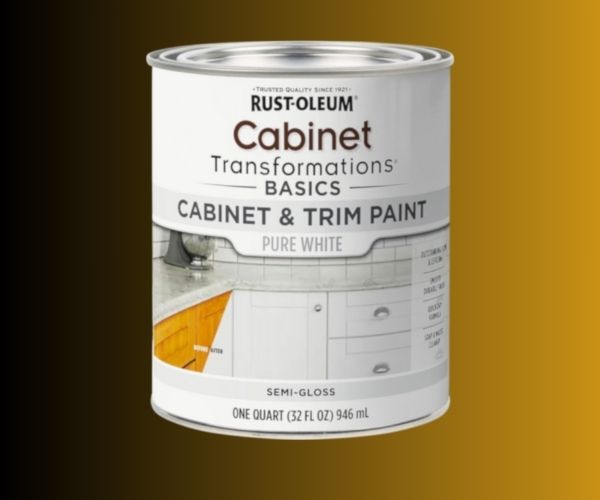
High Durability: Cabinet paint is designed to survive daily usage and is therefore perfect for surfaces in bathrooms and kitchens where moisture, heat, and frequent cleaning are frequent occurrences. And it gives enduring defense against deterioration.
Smooth, Professional Finish: Cabinet paint gives your area a polished, smooth sheen that adds a touch of contemporary elegance. Also it is ideal for folks who value a simple yet elegant appearance.
Color Retention: Cabinet paint is less likely to fade or become yellow over time, keeping your cabinets’ original shade and appearance.
Read More: Silestone Marengo Quartz
Cons of using Cabinet Paint
Despite the many benefits of cabinet paint, there are a few disadvantages to take into account:
Preparation: For the greatest results when painting cabinets, a full surface preparation routine that includes sanding and priming is frequently necessary. Extra step can take some time and requires careful attention to detail.
Limited Aesthetic Options: If you’re going for a distressed or vintage aesthetic, cabinet paint might not be the greatest option. Its glossy appearance works well with a modern or contemporary style.
Chalk Paint vs Cabinet Paint – Key Differences
Understanding the main distinctions between chalk paint and cabinet paint before choosing one for your furniture or cabinets is essential. Let’s examine these differences:
Durability and Longevity:
Chalk Paint: Chalk paint offers a charming aesthetic but is usually less durable, making it best suited for decorative items or low-traffic areas. It can age and show wear more quickly than other paint types, necessitating more frequent touch-ups or refinishing in high-use areas. While visually appealing, its longevity may be a worry for surfaces that experience regular wear and tear.
Cabinet paint: Cabinet paint is especially formulated for exceptional durability, making it ideal for high-traffic areas like kitchens and bathrooms. Because it withstands moisture, heat, and regular cleaning, ensuring a staying pristine appearance. Durability lowers the need for frequent maintenance or repainting. For those prioritizing longevity and a polished look in busy areas, cabinet paint is the clear winner.
Cost
Chalk paint cans typically cost $25 to $40 per quart, making it a reasonably priced option. For DIY enthusiasts, price is a crucial consideration.
Cabinet paint normally costs between $30 and $70 per quart, making it significantly more expensive. Its endurance and expert polish justify the higher cost.
Read More: Caledonia Granite
Finish and Aesthetics
Chalk Paint: For its matte appearance and textured look, chalk paint is recognized. To achieve a vintage or shabby-chic effect, it provides a pleasantly rustic or damaged look.
Projects, where you wish to add character and a hint of nostalgia, can benefit greatly from the matte texture’s warm and inviting vibe.
Because of its adaptability, chalk paint encourages creativity by allowing for methods like distressing or color layering for a distinctive, handcrafted appearance.
Cabinet paints: Cabinet paints, which provide smooth and glossy surfaces, are a popular choice for kitchens. They provide a sense of richness and depth to cabinets with their brilliant gloss.
Customization is important, because it is available in a variety of colors ranging from traditional whites to vivid colors, letting homeowners properly complement their kitchen décor.
Also the longevity of cabinet paint implies that it can survive severe use, dampness, grease, and stains. And Its adaptability gives you control over opacity and coverage by applying many applications as needed. Using cabinet paint, you can stylishly transform your kitchen.
Application and ease of use
Chalk Paint: DIY enthusiasts frequently use chalk paint since it requires little surface preparation and does not require laborious priming and sanding. Beginners and experts of all skill levels can benefit from its thick consistency and superb coverage. Because it encourages creative versatility because it adheres well to many surfaces, including wood, metal, glass, and fabric. Whether a painter is a beginner or an expert, everyone may achieve satisfying results.
Cabinet paints: For improved adhesion and longevity, particularly in high-traffic areas, cabinet paint requires careful preparation, which frequently involves extensive sanding and priming.
This route calls for more skill but yields a finished product that is polished and expert. With increasing emphasis on skilled hands, patience, and precision become essential.
Those who are dedicated to the pursuit of a refined finish will find cabinet paint to be the best option for a polished and long-lasting result.
Color Options
Chalk paint comes in a variety of colors allowing for creativity and personalization. Because colors can be combined to produce specialized tints and effects.
Cabinet paint also provides various color options but may have fewer choices than chalk paint. It does, however, frequently feature a variety of vintage and contemporary hues.
Choosing Between Chalk Paint vs Cabinet Paint
Choosing between chalk paint and cabinet paint is dependent on your specific project and personal tastes. Consider the following factors:
Factors to Consider
Start by assessing what you’re painting and where it will be displayed. Factor may have a considerable impact on your selection.
Aesthetic Preference: Your style preference is important. Are you drawn to the attraction of a distressed, vintage appearance, or are you pulled to the allure of a sleek, modern finish?
Time and Effort: Consider how much preparation work and time you’re willing to put in. Because of some paints necessitate more precise preparation than others.
Examples from Real Life
Let’s look at a couple of real-life examples to illustrate these points:
Situation 1: Assume you’re in the midst of reusing an old dresser to improve the ambiance of your bedroom, with the goal of obtaining a shabby-chic style.
In this scenario, chalk paint is the better option. Its matte sheen and rustic texture lend to the intended vintage impression seamlessly.
Situation 2: Assume your project involves refinishing your kitchen cabinetry. You want a long-lasting, modern look that will withstand the demands of regular use.
Cabinet paint takes center stage as the preferable option in this case. Also its durability and smooth surface are ideal for achieving a timeless and stylish kitchen remodel.
FAQ
In order to increase durability, chalk paint can be used on kitchen cabinets, but it must be carefully sealed.
Cabinet paint offers long-term durability but might be more expensive due to the additional prep work and layers needed.
While professional applications can produce the greatest results, DIY enthusiasts can produce outstanding results with proper preparation and technique.
Yes, you can experiment with both paints to produce a unique look, but make sure to try it out first in a small area.
Avoid abrasive materials and keep things clean frequently. To retain the finish over time, you might need to reapply wax or topcoat.


